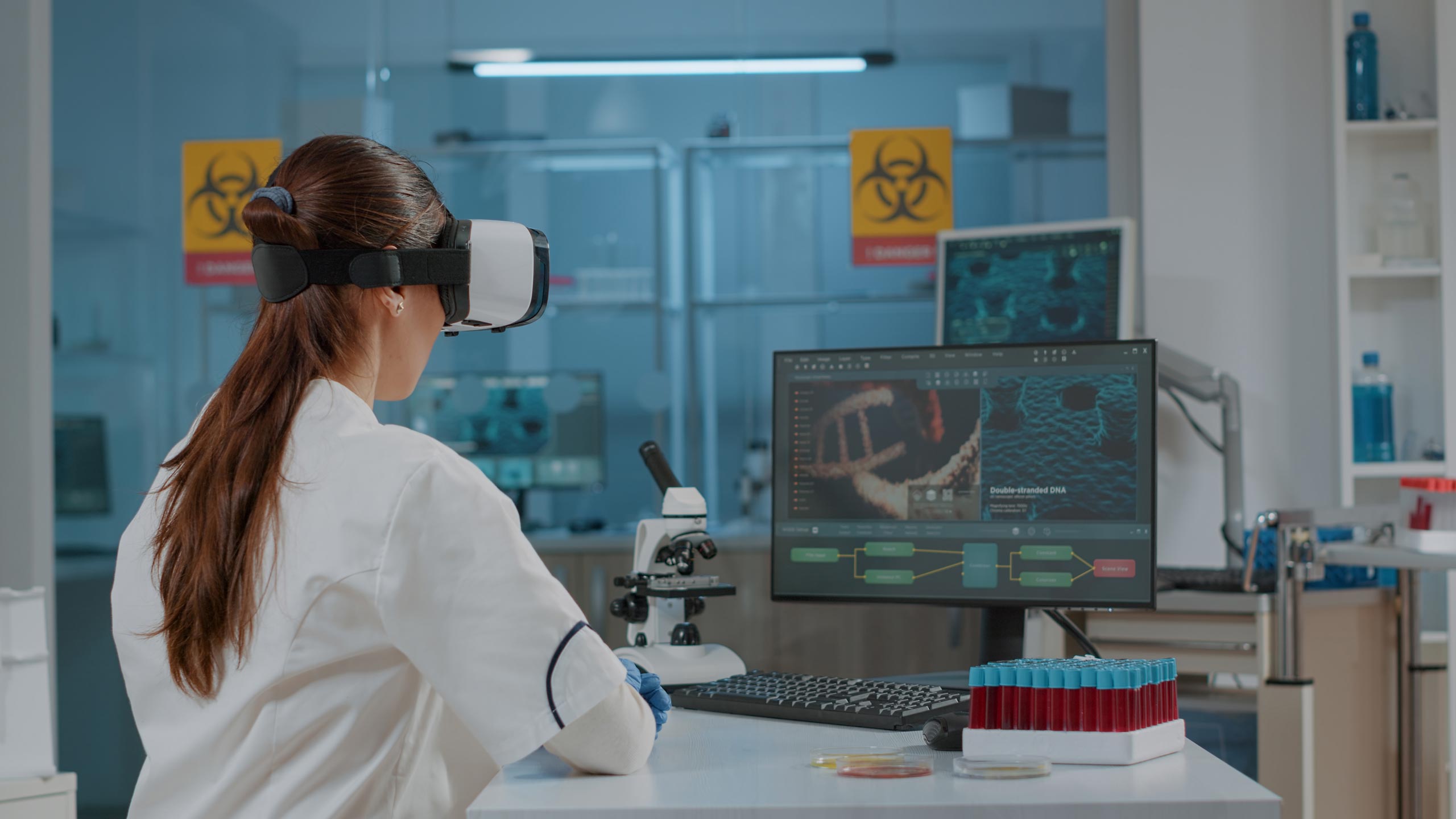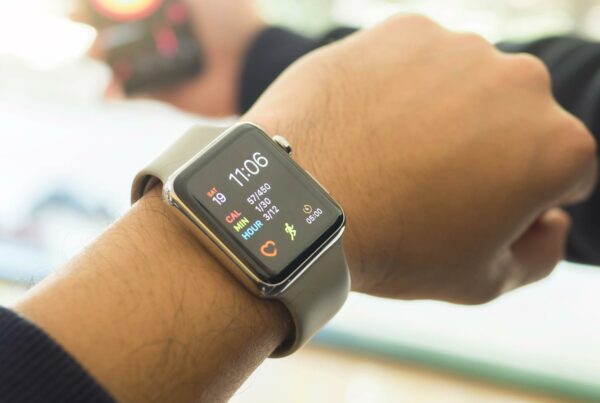While Virtual Reality (VR) is synonymous with gaming, its applications are vast and varied in other industries such as healthcare, transportation, military, aerospace, etc.
The pandemic-fueled digital rush has further accelerated the development of VR in healthcare. By its very nature, VR is non-contact and allows providers and patients to connect in a virtual world and receive personalized care. The technologies can simulate a wholly immersive experience (VR) or include real-world sensory aspects (AR).
VR in the healthcare industry has moved from science fiction to real-life clinics and hospitals across the country. Though VR technology in healthcare is relatively new, its positive impact on patients’ lives and physicians’ work is undeniable. As a result, the VR industry is anticipated to grow by more than 36%.
In this post, we list a few applications of VR in the healthcare industry.
High impact applications of VR in healthcare
Medical training
Today, medical training is less about rote memorization and more about learning real-life skills. Any body part in humans or animals can be recreated using VR technology. This paves the way for medical students to learn their craft by simulating dissections rather than using real corpses. In addition, VR allows students to deal with simulated emergencies and conditions.
A recent Harvard Business Review study found that surgeons trained in VR were 230% better at their jobs than surgeons trained conventionally.2 The American Board of Internal Medicine (ABIM) has also said that owing to its effectiveness in imparting standardized instruction, this form of training is ideal before treating patients in real life.3
Virtual reality in surgery
In addition to its use in teaching future surgeons, VR technology in healthcare has immense appeal among doctors. Surgeons can simulate complex surgeries in a VR environment to determine their success factor. They can also simulate common emergency conditions and devise a plan that has the highest chances of success and risk mitigation.
Surgeons across different locations can also collaborate virtually and determine novel approaches for complex surgeries. Using robotic assistance, multiple surgeons spanning thousands of miles can perform complex surgeries, resulting in top-notch care provision for patients.
In a pilot trial, patients being operated on at St. George’s Hospital in London had the option of using a virtual reality (VR) headset to view relaxing landscapes before and during their operation. 100% of participants said that using the headset enhanced their overall clinical experience, while 94% reported feeling calmer. Furthermore, 80% reported less pain, and 73% reported less anxiety after using the headset. 4
Psychiatric treatment
Fears, phobias, and post-traumatic stress disorder can be addressed using virtual reality. Patients are gradually introduced to a simulated environment that mimics their fearful situation. The therapist then measures the patient’s brain activity under stress. Through virtual reality apps, clinicians can comprehend the brain and biochemical components behind each instance of PTSD for more effective therapy.
Using moderate exposure tactics and counseling on responding to addiction cravings, VR technology in healthcare can aid in recovery from drug dependence. The patient’s surroundings in the simulated situation help practice resistance to usual triggers before facing the actual trigger.
VR Head Mounted Displays (HMD) also help autistic patients. Autistic children and adults are exposed to the “real world” in a virtual context, and appropriate social skills training is provided.
Pain management
Doctors have historically treated various pains using cognitive distraction. Interactive VR games support these approaches. For example, some apps provide therapeutic VR for burn survivors, while others make injections more bearable for children. There are also advanced measures to facilitate efficient limb pain management.
VR also serves as a drug-free pain management measure that can be used with or without clinical care settings. It can distract and relieve pain, particularly when anesthesia or sedation is contraindicated. While patients are isolated, healthcare institutions can establish or expand VR programs for self-guided rehabilitation and chronic pain.
Fitness and physical therapy
The fitness industry is seeing a significant shift in how exercises are performed. Start-ups are integrating cardiac regimens with virtual reality to transform the way we work out. In addition, numerous fitness apps incorporate VR to encourage daily physical activity by making it more enjoyable. They either gamify physical training, offer objectives and incentives, provide feedback on the motions, or enhance the experience by immersing the user in a motivating environment.
VR also plays a significant part in rehabilitation, as patients are exposed to an exercise regime that involves VR rather than medicines or invasive procedures. VR can also improve recovery periods by making patients’ activities more straightforward. Diverting the patient’s attention away from the pain can engage and encourage them to accomplish the task. Similarly, patients recovering from a stroke can practice certain motions without risking additional injuries, increasing their confidence in the virtual environment.
Nascent Applications of VR in the Healthcare Industry
Improving dental treatment
Dentists can boost the efficacy of dental treatment by using VR glasses and headphones to distract patients from their anxiety during dental procedures or by developing a virtual model of their mouths for academic purposes. VR is also used to see how dentures fit patients and the tweaks needed for a perfect first fit.
Better patient engagement and diagnostics
VR helps doctors, nurses, and other medical professionals communicate with people through different human simulation approaches. For example, they can participate in various training sessions, interact with patients in a 3D environment, utilize sensors to evaluate the participant’s emotions, explain procedures to patients, and distract mothers-to-be in labor.
VR helps doctors make accurate diagnoses. In conjunction with MRI / CT scans, this is painless for the patient and requires no invasive procedures.
Aiding cognitive recovery
Like for physically ill people, VR may hasten cognitive therapy and recovery. VR neuro-rehabilitation gaming systems assist patients in regaining their motor and cognitive skills. VR technologies capture and monitor all behaviors and personalize the virtual experience, allowing patients to interact and practice challenging tasks. As a result, it would speed up the patient’s recovery and confidence.
Innovative inroads in ophthalmology
Virtual and augmented reality may assist individuals with low vision in better seeing and identifying objects. It enables patients to enlarge preferred elements in the visual scene without losing knowledge of their surroundings. Users have control over their vision and can choose the appropriate magnification level.
Conclusion
Virtual reality can add tangible value to patients, doctors, and practitioners in the healthcare business.
As more data and studies become accessible, the rationale for using AR and VR for virtual care and chronic illness management will become more robust. In addition, with increased adoption, VR could become part of routine care plans, making them more cost-effective and increasing their likelihood of being included in standard insurance plans.
With core technology improvements, AR and VR technology will only become more inexpensive and easier to use. VR-specific applications are likely to increase as adoption grows, thus building a sustainable ecosystem of hardware, software, users, and providers.
References
- “Global Research Study on Virtual Reality in Healthcare Market Size Will Reach $2793.69 Million, at 36.50% CAGR by 2028: Comprehensive Research Report by Facts & Factors.” Globe Newswire News Room, August 8, 2022. https://www.globenewswire.com/en/news-release/2022/08/08/2494317/0/en/Global-Research-Study-on-Virtual-Reality-in-Healthcare-Market-Size-Will-Reach-2793-69-Million-at-36-50-CAGR-by-2028-Comprehensive-Research-Report-by-Facts-Factors.html.
- Blumstein, Gideon. “Research: How Virtual Reality Can Help Train Surgeons.” Harvard Business Review, October 16, 2019. https://hbr.org/2019/10/research-how-virtual-reality-can-help-train-surgeons.
- Samadbeik, Mahnaz, Donya Yaaghobi, Peivand Bastani, Shahabeddin Abhari, Rita Rezaee, and Ali Garavand. “The Applications of Virtual Reality Technology in Medical Groups Teaching.” PubMed Central (PMC). Accessed November 29, 2022. https://www.ncbi.nlm.nih.gov/pmc/articles/PMC6039818/.
- St George’s University Hospitals NHS Foundation Trust. “VR Headsets Relaxing Patients during Surgery at St George’s – St George’s University Hospitals NHS Foundation Trust.” Accessed November 29, 2022. https://www.stgeorges.nhs.uk/newsitem/vr-headsets-relaxing-patients-during-surgery-at-st-georges/.














